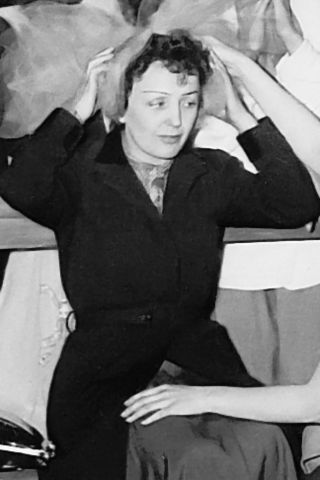Édith Piaf
French singer (1915–1963) From Wikipedia, the free encyclopedia
Remove ads
Édith Piaf (aka. "La Môme Piaf") (December 19, 1915 – October 11, 1963)[1] was one of France's most-loved singers. Her real name was Édith Giovanna Gassion. She became a national icon. Her music was an image of her tragic life. Piaf was known for singing ballads in a heartbreaking voice.
Remove ads
Life and career
As child at her grandmother's in Normandy, she suffered from keratitis, but 1925 - 10 A pilgrimage to Lisieux in the Normandy honoring Saint Thérèse of Lisieux / (Sainte Thérèse de l'Enfant-Jésus), and the intense devoutness of the family resulted in a miraculous healing, Édith said.
1930 – 15 Her manager gave her the stage name "la môme Piaf", "la Môme", Édith Piaf, or just Piaf. She was only 1.47 metres (4 ft 10 in) tall and puny, but sharp and lively like a sparrow. She always wore a black dress on the stage.
She sang first in Pigalle, then in Le Gerny, the nightclub of Louis Leplée near the Champs-Élysées. She met Raymond Asso (1901-1968) and Marguerite Monnot (1903-1961), who wrote and composed her best songs; she stroke up an acquaintance with actor and singer Maurice Chevalier.
1948 – 32 The love of Piaf's life, the boxer Marcel Cerdan, middleweight champion of the world, died in a plane crash in October 1949, in the Azores, while flying from Paris to New York City to meet her.
1952 – 36 Piaf married Jacques Pills in 1952 (her matron of honour was Marlene Dietrich). She divorced him in 1956. In 1962, she wed Théo Sarapo (Theophanis Lamboukas), a Greek hairdresser who was 20 years her junior.
She suffered from different illnesses during her life, especially after several car crashes.
1963 – 47 Piaf died of liver cancer at Plascassier, near Grasse (Département Alpes-Maritimes), on 10 October 1963.[2]
Among her most famous songs are "Mon légionnaire" (1936), "Le fanion de la Légion" (1936), "La vie en rose" (1946), "Hymne à l'amour" (1949), "Padam... Padam..." (1951), "l'Accordéoniste" (1955), "Les amants d'un jour" (1956),"La foule" (1957), "Milord" (1959) and "Non, je ne regrette rien" (1960).
Although she was denied a solemn funeral mass, her funeral procession from her residence, Boulevard Lannes (Paris, XVI arr.) drew tens of thousands of mourners onto the streets of Paris, that caused a huge traffic jam. The ceremony at the cemetery‚ Le Père-Lachaise (Paris, XX arr.), was attended by more than 100,000 fans.
Albums: Chansons Parisiennes (1949)Chansons des Cafés de Paris (1950)Edith Piaf (1953)Le Tour de Chant d'Édith Piaf a l'Olympia - No. 1 (1955)Le Tour de Chant d'Édith Piaf a l'Olympia - No. 2 (1956)Le Tour de Chant d'Édith Piaf a l'Olympia - No. 3 (1958)Récital 1961Récital 1962
Remove ads
References
- Huey, Steve. Edith Piaf: Biography. Yahoo! Music.
Notes
Other websites
Wikiwand - on
Seamless Wikipedia browsing. On steroids.
Remove ads

